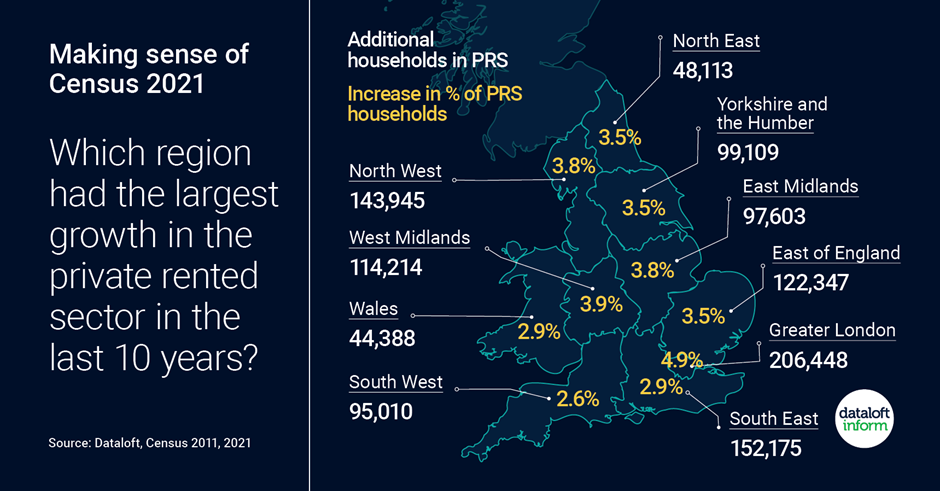Over the past decade, the private rented sector (PRS) has experienced significant growth in the UK. In this article, we’ll delve into the data provided by Dataloft Inform to explore the regional changes that have occurred between 2011 and 2021. With a rise of 1.1 million households renting privately during this period, the PRS now accounts for 20% of households in England and Wales, up from 17% in 2011.

This growth has been widespread, with all regions in England and Wales recording increases in the PRS. The figures range from a modest 2.6% growth in the South West to a substantial 4.9% increase in Greater London. The latter has seen the most significant expansion, both in terms of the absolute number of extra households and the change in the proportion of households living in the PRS.
The City of London experienced the largest increase in the proportion of PRS households, with a 12.6% jump. Following closely behind was Salford in Greater Manchester, where PRS households grew by 8.1%. These figures demonstrate the dynamic nature of the PRS and highlight the increased demand for rental properties in key urban areas.
Now let’s take a closer look at the region-by-region growth of the PRS:
- North West: The region witnessed an increase of 143,945 PRS households, representing a 3.8% growth.
- West Midlands: The area experienced a 3.9% increase in PRS households, with an additional 114,214 properties.
- Wales: The country saw a 2.9% growth in the PRS, adding 44,388 households.
- South West: The region experienced a 2.6% increase in PRS households, with an additional 95,010 properties.
- South East: The area saw a 2.9% growth in PRS households, adding 152,175 households.
- Greater London: With a 4.9% increase, the region experienced the largest growth, adding 206,448 PRS households.
- East of England: The region saw a 3.5% increase in PRS households, with an additional 122,347 properties.
- East Midlands: The area experienced a 3.8% growth in the PRS, adding 97,603 households.
- Yorkshire & Humber: The region saw a 3.5% increase in PRS households, with an additional 99,109 properties.
- North East: The area experienced a 3.5% growth in the PRS, adding 48,113 households.
These regional changes are a clear indication that the private rental sector has become an increasingly popular housing option for many people across the UK. Various factors have contributed to this growth, including increased demand for flexible living arrangements, a lack of affordable housing options, and changing social attitudes towards renting.
The growth of the PRS is particularly noticeable in large urban areas, where property prices have often soared beyond the reach of many potential buyers. In these locations, renting has become the only viable option for a growing number of households.
As the PRS continues to expand, it’s essential for policymakers, landlords, and tenants to adapt to the changing landscape. This includes ensuring that rental properties are of a high standard, that tenants’ rights are protected, and that the supply of rental properties meets the demand. The government, local authorities, and the private sector must work together to develop solutions that address the challenges faced by the PRS.
In conclusion, the private rental sector in the UK has experienced significant growth over the past decade, with a total increase of 1.1 million households choosing to rent privately. This expansion has been felt across all regions, with Greater London experiencing the most substantial growth. As more people opt for rental properties as their preferred housing choice, it is crucial that the sector continues to evolve and adapt to meet the needs of an ever-growing tenant population.






